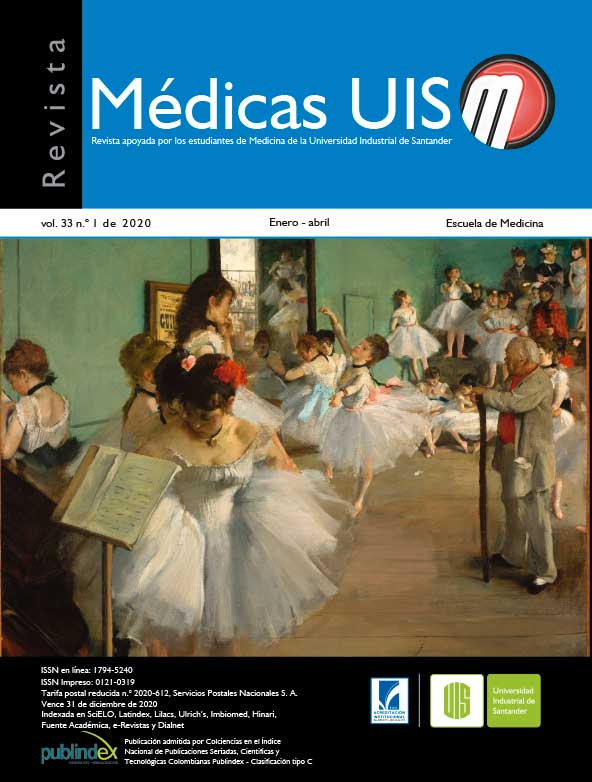Abstract
The results of medical marijuana research have brought to the government tables discussions about their therapeutic potential and the measures to be taken to control their production, commercialization and use. In Colombia, since 2017, the medical cannabis market is regulated; however, there are gaps between the laws, availability and the access of patients to pharmaceutical products with cannabis derivatives approved by the regulatory entity and that comply with the standards of quality. From this perspective, it is necessary forthe national government to lead, in coordination with the academy and the productive sector, the development of pharmaceutical preparations based on cannabis and to establish and implement strategic and concerted measures, aimed to improve access and proper use of medical marijuana pharmaceutical products, mainly for cases in which a clear risk/benefit relationship can be established. This would help to improve the health conditions of patients who can get benefits from these options, as well as the development and consolidation of a promising sector for the country. MÉD.UIS.2020;33(1):53-8.
References
2. Pertwee RG. Emerging strategies for exploiting cannabinoid receptor agonists as medicines. Br J Pharmacol. 2009;156(3):397–411.
3. Bridgeman MB, Abazia DT. Medicinal Cannabis: History, Pharmacology, And Implications for the Acute Care Setting. P T Peer-Rev J Formul Manag. 2017;42(3):180–8.
4. Resstel LBM, Tavares RF, Lisboa SFS, Joca SRL, Corrêa FMA, Guimarães FS. 5-HT1A receptors are involved in the cannabidiol-induced attenuation of behavioural and cardiovascular responses to acute restraint stress in rats. Br J Pharmacol. 2009;156(1):181–8.
5. Schier AR de M, Ribeiro NP de O, Silva AC de O e, Hallak JEC, Crippa JAS, Nardi AE, et al. Cannabidiol, a Cannabis sativa constituent, as an anxiolytic drug. Rev Bras Psiquiatr Sao Paulo Braz 1999. 2012;34 Suppl 1:S104-110.
6. O’Connell BK, Gloss D, Devinsky O. Cannabinoids in treatment-resistant epilepsy: A review. Epilepsy Behav EB. 2017;70(Pt B):341–8.
7. Whiting PF, Wolff RF, Deshpande S, Di Nisio M, Duffy S, Hernandez AV, et al. Cannabinoids for Medical Use: A Systematic Review and Meta-analysis. JAMA. 2015;313(24):2456–73.
8. Martin-Santos R, A. Crippa J, Batalla A, Bhattacharyya S, Atakan Z, Borgwardt S, et al. Acute Effects of a Single, Oral dose of d9-tetrahydrocannabinol (THC) and Cannabidiol (CBD) Administration in Healthy Volunteers. Curr Pharm Des. 2012;18(32):4966–79.
9. Ministerio de Salud y Protección Social. Decreto 613 de 2017. oct 4, 2017.
10. Einhorn LH, Nagy C, Furnas B, Williams SD. Nabilone: an effective antiemetic in patients receiving cancer chemotherapy. J Clin Pharmacol. septiembre de 1981;21(S1):64S-69S.
11. Zajicek J, Fox P, Sanders H, Wright D, Vickery J, Nunn A, et al. Cannabinoids for treatment of spasticity and other symptoms related to multiple sclerosis (CAMS study): multicentre randomised placebo-controlled trial. Lancet Lond Engl. el 8 de noviembre de 2003;362(9395):1517–26.
12. Devinsky O, Cross JH, Laux L, Marsh E, Miller I, Nabbout R, et al. Trial of Cannabidiol for Drug-Resistant Seizures in the Dravet Syndrome. N Engl J Med. el 25 de mayo de 2017;376(21):2011–20.
13. Food and Drug Administration. Cesamet Label. [Internet]. 2006. Disponible en: https://www.accessdata.fda.gov/drugsatfda_docs/label/2006/018677s011lbl.pdf
14. Food and Drug Administration. Marinol. Highlights of prescribing information. [Internet]. 2017. Disponible en: https://www.accessdata.fda.gov/drugsatfda_docs/label/2017/018651s029lbl.pdf
15. Food and Drug Administration. Epidiolex. Highlights of prescribing information. [Internet]. 2018. Disponible en: https://www.accessdata.fda.gov/drugsatfda_docs/label/2018/210365lbl.pdf
16. European Medicines Agency. Epidyolex [Internet]. European Medicines Agency. 2019 [citado el 25 de febrero de 2020]. Disponible en: https://www.ema.europa.eu/en/medicines/human/EPAR/epidyolex
17. Agencia Española de Medicamentos y Productos Sanitarios. SATIVEX [Internet]. [citado el 25 de febrero de 2020]. Disponible en: https://cima.aemps.es/cima/publico/detalle.html?nregistro=72544
18. Health Canada. Fact Sheet SATIVEX [Internet]. 2005 [citado el 25 de febrero de 2020]. Disponible en: https://www.canada.ca/en/health-canada/services/drugs-health-products/drug-products/notice-compliance/conditions/fact-sheet-sativex.html
19. Agencia Nacional de Vigilancia Sanitaria-Brasil. Mevatil [Internet]. [citado el 25 de febrero de 2020]. Disponible en: https://consultas.anvisa.gov.br/#/medicamentos/25351738074201441/?nomeProduto=Mevatyl
20. Instituto Nacional de Vigilancia de Medicamentos y Alimentos. Consulta Registros Sanitarios [Internet]. [citado el 23 de octubre de 2019]. Disponible en: http://consultaregistro.invima.gov.co:8082/Consultas/consultas/consreg_encabcum.jsp
21. Instituto Nacional de Vigilancia de Medicamentos y Alimentos. Listado de plantas medicinales [Internet]. 2019 [citado el 23 de octubre de 2019]. Disponible en: https://paginaweb.invima.gov.co/normatividad/normatividad-interna/proyectos.html
22. Australian Government Department of Health Therapeutic Goods. Guidance for the use of medicinal cannabis for the prevention or management of nausea and vomiting in Australia [Internet]. 2017 [citado el 23 de octubre de 2019]. Disponible en: https://www.tga.gov.au/publication/guidance-use-medicinal-cannabis-prevention-or-management-nausea-and-vomiting-australia
23. Makary P, Parmar JR, Mims N, Khanfar NM, Freeman RA. Patient Counseling Guidelines for the Use of Cannabis for the Treatment of Chemotherapy-Induced Nausea/Vomiting and Chronic Pain. J Pain Palliat Care Pharmacother. 2018;32(4):216–25.
24. Instituto Nacional de Vigilancia de Medicamentos y Alimentos. Guía para las visitas de buenas prácticas de elaboración de preparaciones magistrales a base de cannabis [Internet]. 2020 [citado el 30 de enero de 2020]. Disponible en: https://www.invima.gov.co/documents/20143/908412/guia-para-las-visitas-de-buenas-practicas-de-elaboracion-de-preparaciones-magistrales-a-base-de-cannabis_ASS-AYC-GU017.pdf/8021bdd8-13f1-4cf6-fe69-39163ee09eef?t=1572042596864
25. Ministerio de Salud y Protección Social. Resolución 315 de 2020. mar 2, 2020.
26. Ministério da Saúde/Agência Nacional de Vigilância Sanitária/Diretoria Colegiada. Resolução da diretoria colegiada - RDC No327, de 9 de dezembro de 2019. Dispõe sobre os procedimentos para a concessão da Autorização Sanitária para a fabricação e a importação, bem como estabelece requisitos para a comercialização, prescrição, a dispensação, o monitoramento e a fiscalização de produtos de Cannabis para fins medicinais, e dá outras providências. [Internet]. 2019 [citado el 30 de enero de 2020]. Disponible en: http://www.in.gov.br/en/web/dou/-/resolucao-da-diretoria-colegiada-rdc-n-327-de-9-de-dezembro-de-2019-232669072
